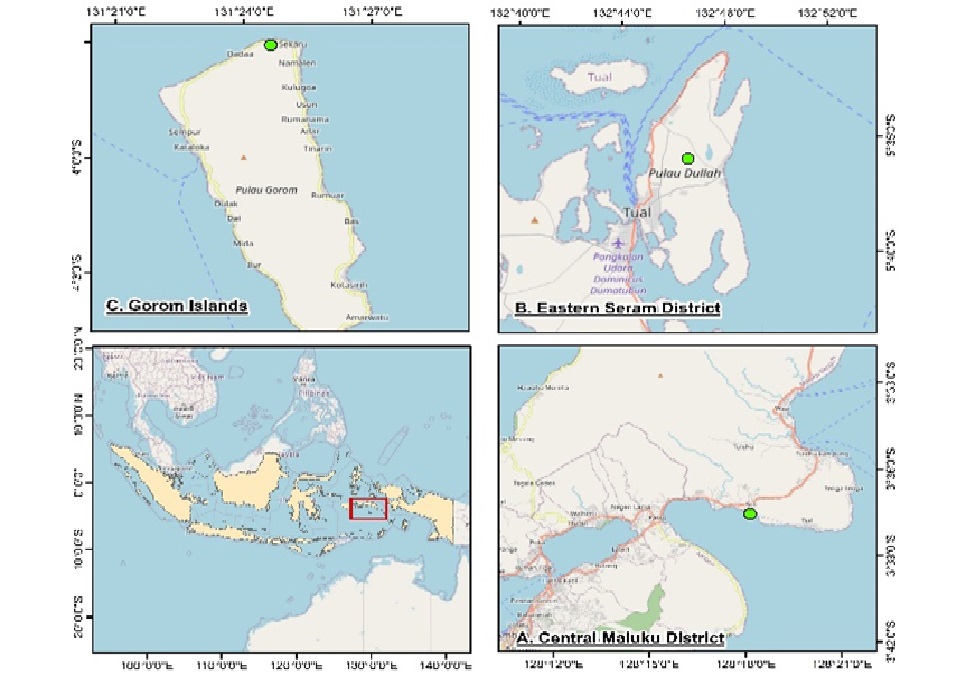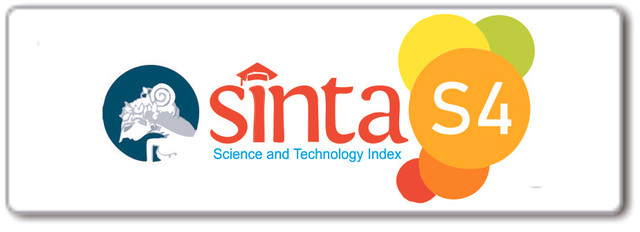Macroalgae As a Source of Food And Health For Coastal Communities in Moluccas Province
Abstract
These various types of macroalgae have an important role in the lives of coastal communities as a source of nutritious food and also have ecological and biological functions in maintaining the stability of marine ecosystems and as a place to live and protect other biota. This group of macroalgae has economic potential, namely as food, raw materials in industry and health. To find out macroalgae as a source of food and health, a study was carried out using a collaborative experimental research approach in the F-MIPA Laboratory at Pattimura University and field surveys in various districts of Moluccas Province.Types of macroalgae consumed by people in Maluku Province include: Eucheuma conttonii, Gracilaria salicornia, Caulerpa lentillifera, Kappaphycus alvarezii, Gracilaria arcuate species. Of these 5 types of macroalgae, 4 species are red macroalgae class Rhodophycea and 1 species is green macroalgae class Chrorophycea. The results of proximate analysis show that macroalgae are consumed by the public. The highest carbohydrate content in the macrolaga Gracilaria arcuata was 2.1370%, the highest proteins content in the macroalgae Eucheuma conttonii was 0.9161%, the fat content in the macrogaze was highest in the Kappaphycus alvarezii type at 0.4053%, the highest ash content in the macroalgae was in the Eucheuma conttonii type at 5.8155%. The highest water content contained in various types of macroalgae in the macroalgae Caulerpa lentillifera was 93.5485%. There is a linear correlation between the knowledge of coastal communities in several districts of Maluku Province who consume macroalgae as a source of food and health, and the attitude of coastal communities towards cooking menus made from macroalgae. This is proven by the analysis results showing an R value of 2 = 0.779, which means there is a significant correlation between knowledge. and public attitudes about macroalgae as a source of food and health. The existence of this significant relationship is due to the influence of knowledge of 77.9% on the attitudes of people who consume macrolaga, and only 22.1% is influenced by other factors. The results of the analysis show that there is an influence of knowledge on people's attitudes about macrolags as a source of food and health. According to the results of the analysis, it shows a value of df = 44-43 = 1 with a value of F = 221,690 with a significance level of 000, <p 0.05, this means that there is The significant influence between people's knowledge and attitudes towards the food menu comes from various types of macroalgae.
Downloads
References
Ashar, R. R. 2021. Quality of Kappaphycus alvarezii macrolaga cragility based on depth level in the waters of Balo-Balo Village, Wotu District, East Luwu Regency. Makasar State Islamic University. Faculty of Science and Technology UIN Alaudin Makasar.
Basir, M. A., Sairun, R., Samburoto, Y., Wabula, S., & La Hardin. 2023. Empowerment of Coastal communities in seaweed farming groups. Journal of Community Civilization, 3(1).
Cahyadinata, I., Nusril, K.S., & Priyono, B. S. 2019. Study of the Food security of Enggano Island Coastal communities and its effects on the welfare of the outermost small island development strategy. Faculty of Agriculture, Bengkulu University.
Chairudin, D. Y., Kumampung, D. R. H., Kaligis, E. Y., Wagey, B. T., Rimper, J. R. T. S. L., & Kemer, K. (2023). Algae community structure around the waters of Meras Village, Bunakan District, Manado City. Tropical Coastal and Marine Journal, 11(2), 152-159.
Da Conceicao, J. D., Sunadji., Marcelien, Dj., Oedjoe, R. 2023. Public perception of socio-economic changes in the spread of PLTU Bolok waste towards seaweed cultivation activities in the waters of West Kupang District. Aquatic Journal, 6(2).
Damongilala, L. J. 2021. Nutrient content of fish food. Patra Media Grafindo: Bandung.
Domu, U., & Meiyasa, F. 2023. Exploration of macroalgae diversity and analysis of chemical composition based on abundance in Warambadi Waters, East Sumba. Journal of Tropical Fisheries Processing (JPPT), 1(1), 029-039.
Faaizah, N. 2023, Europeans were fond of consuming seaweed 8 thousand years ago, read detikedu's article.https://www.detik.com/edu/detikpedia/d-7068086/orang-eropa-gemar-konsumsi-rumput-laut. Accessed June 8, 2024.
Fatriyanti, D., Warsidah., Sofiana, M. S. J., & Helena, S. (2022). Analysis of the Proximate and mineral zinc content of the macroalgae Eucheuma cottonii in the Lemukuta Watershed. Oceanologia, 1(1), 28-32.
Gusman, I., Diharmi, A., Sari, N. I. 2021. Chemical composition of dried red seaweed (Eucheuma cottonii). Faculty of Fisheries and Marine Affairs, University of Riau Pekanbaru.
Harwindito, B., & Patty, L.A. (2021). Analysis of the healthy food menu at restaurant Saladbar by Hadi kitchen at Mall Kelapa Gading. Indonesian Tourism Journal, 17(2).
Husain, H., & Sulolipu, A. A. 2023. Efforts made by coastal communities regarding community exploration in Biangkeke Village, Pajukukang District, Banteng Regency. Patompo University Makassar, Indonesia JIGE, 4(4), 2288-2299.
Irawan, H. N., Novita, F., Marifah, K., Sulaimani, A., Budyawati, Arfasari, M., & Afrilda, Y. 2022. Healthy kitchen to overcome stunting in a quality family village (dashat) variety of healthy and nutritious menus for stunting care students. National Population and Family Planning Agency (BKKBN).
Jumiati, A., & La Aba. 2023. Identification of maroalgae types in the intertidal zone of Lagilang Beach, West Siompu District, South Buton Regency. Penalogik: Journal of Biology and Educational Research, 2(2).
Kasman. 2019. Knowledge System for seaweed farmers in Gonebalo Village, Duruka District, Muna Regency. Ethnoreflica. Social and Cultural Journal, 8(1), 64 – 71.
Kepel, R. C., & Mantiri, D. M. H. 2019. Macroalgae biodiversity in Kora-Kora Coastal Waters, East Lembean District, Minahasa Regency. Platax Scientific Journal, 7(2).
Khotijah, S., Irfan, M., & Muchdar, F. 2020. Nutritional composition of seaweed Kappaphycus alvarezi. Journal Fisheries Agribusiness, 13(2), 139-146. DOI: 10.29239 lj agrikan 13.2.139-146.
Kuswandono, A. 2020. Guidelines for measuring Indonesian ocean health. Coordinating Ministry for Maritime Affairs and Investment: Jakarta..
Lokolo, F. (2019). Community of macro algae in Erie coastal waters Ambon Bay. TRITON Journal, 15(1), 40- 45.
Nasution, A. S., Hasibuan, A. S., Thoibah, B., Pratiwi, D. A., Ayenti, E., Pratiwi, K.P., Barus, M. Br., Sirait, A. A., & Priyatna, S. H. (2024). Study of Coastal community behavior that resulted in environmental damage on the mangrove beach of Tanjung Rejo Village Percut District SEI Tuan. El-Mujtama. Journal of Community Service, 4(2), 751-758.
Nurdaya, T. 2023. Socialization of functional food from marine resources to the Sambong Coastal Community, Bontotiro District. PKM Bina Bahari Journal, 3.
Pakidi, C. S., & Suwoyo, H. S. (2017). Potential Utilization of active ingredients of brown algae Sargassum sp. Oktopis Journal, 6(1).
Prinata 2024. Types of Edible seaweed and their benefits. There are many types of seaweed that can be eaten. Most of them are cultivated in the Asian region, including Indonesia. IWST, https://tirto.id/jen-jen-rumput-laut-yang-bisa-dimakan-dan-besarnya-gXiP, Accessed June 8 2024.
Ramdan, M. R., & Nuraeni, E, 2021 Identification of the morphology of Ulva intestinalis and Acanthophora spicifera in the Tanjung Layar Beach Area, Sawarna, Bayah, Lebak Regency, Banten. Tropical Bioscience: Journal of Biological Science, 1(1).
Ridhani, D. T., & Sukmana, H. (2023). Community empowerment through the seaweed village program. Journal of Social Sciences and Humanities, 4(2).
Rosemary, T. A., Arulkumar, S., Paramasivam, A., Mondragon, P., & Miranda, J. M. 2019. Biochemical, micronutrient and physicochemical properties of the dried red seaweeds Gracilaria edulis and Gracilaria corticata. Molecules, 24(2225), 1–14. https://doi.org/ 10.3390/ molecules 241-22225.
Rugebregt, M. J., Pattipeilohy, F., Matuanakotta, C., Ainarwowan, A., Abdul, M. S., & Kainama F. 2021. Potential of seaweed in East Seram Waters, East Seram Regency, Maluku Deep Sea Research Center – LIPI 2 School of Environmental Sciences, University of Indonesia. Journal of Environmental Science, 19(3), 497-510.
Sanger, G., Kaseger, B. E., Rarung L. K., & Damongilala L. (2018). The potential of several types of seaweed as functional food ingredients, sources of natural pigments and antioxidants. Journal of Indonesian Fishery Product Processing, 21(2), 208-217.
Santika, J., Sukmiwati, M., & Diharmi, A. 2021. Chemical Composition of fresh green seaweed (Caulerpa lentillifera). Faculty of Fisheries and Maritime Affairs, Riau University, Pekanbaru.
Septiyaningrum, S., Utami, M. A. F., & Johan, Y. 2020. Identification of sea grape types (Caulerpa sp.) Sepang Bay, Benkulu City. Fisheries Journal, 10(2), 195-204 DOI: https://doi.org/10.29303/jp.v10i2.215.
Suparmin., Zubair, M., Sudjatmiko, D. P., & Zaini, A. 2022. Assistance to Coastal community groups in seaweed cultivation business in Sengkol Village. Journal of Master of Science Education Service, 5(4). https://doi.org/10.29303/jpmpi.v5i4.2510.
Ulfa, S. W., Mawaddah, H., Lubis, I. R., Lubis, M. F. M., & Amalia, Q. 2024. Identification of Medicinal products made from algae (micro algae or macroalgae) in traditional/modern markets in Medan City. El-Mujtama: Journal of Community Service, 4(2). DOI: 10.47467/elmujtama. v4i2.4300.
Yudiati, E., Ridho, A., Nugroho, A. A., Sedjati, S., & Maslukah, L. (2020). Analysis of agar, pigment and proximate content of seaweed Gracilaria sp. in the reservoir and biofilter of Litopenaeus vannamei Shrimp Ponds. Marina Oceanography Bulletin, 9(2), 133-140.

Copyright (c) 2024 Hasan Tuaputty, Pamela Mercy Papilaya, Prelly Tuapattinaya, Cornelia Parry, Saiful Alimudi

This work is licensed under a Creative Commons Attribution-NonCommercial-ShareAlike 4.0 International License.
Authors who publish with BIOEDUPAT: Pattimura Journal of Biology and Learning agree to the following terms:
- Authors retain copyright and grant the journal right of first publication with the work simultaneously licensed under a Creative Commons Attribution License (CC BY-NC-SA 4.0) that allows others to share the work with an acknowledgment of the work's authorship and initial publication in this journal.
- Authors are able to enter into separate, additional contractual arrangements for the non-exclusive distribution of the journal's published version of the work (e.g., post it to an institutional repository or publish it in a book), with an acknowledgment of its initial publication in this journal.
- Authors are permitted and encouraged to post their work online (e.g., in institutional repositories or on their website) prior to and during the submission process, as it can lead to productive exchanges, as well as earlier and greater citation of published work.








 This work is licensed under a
This work is licensed under a 